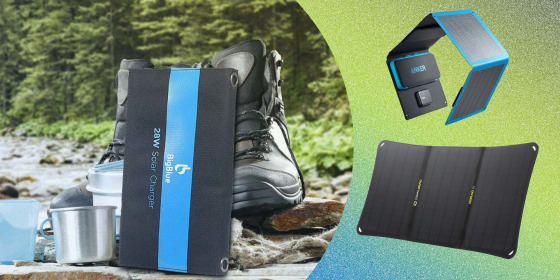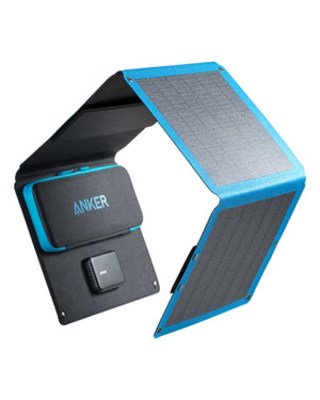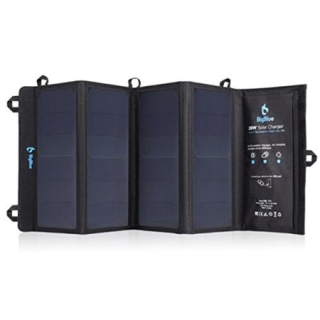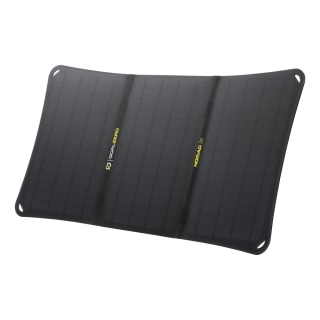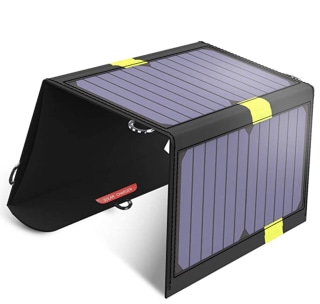Aligned with our interest in emergency kits, we’ve been looking into what items should go inside of them, according to agencies like the Federal Emergency Management Agency. Among first aid kits and flashlights, FEMA’s emergency readiness resource Ready suggests packing a cellphone with chargers and a backup battery. One type of backup battery is a solar charger, which uses sunlight to help charge your electronics, a useful feature during emergencies and convenient for camping and hiking trips.
SKIP AHEAD Highly rated solar chargers | How to shop for a solar charger
Solar chargers are beneficial because they can help repower devices wherever you (and they) are, harnessing energy from the sun and converting it into electrical energy to power phones, tablets and other electronics, explained Sudip K. Mazumder, a professor at the University of Illinois Chicago’s Department of Electrical and Computer Engineering. But how much power a solar charger generates is entirely dependent on how much sunlight is available in your environment. This changes depending on the weather, time of day, location and season.
“A solar cell can’t harness what isn’t there,” Mazumder said. That’s one of the reasons tech expert Whitson Gordon previously advised against using solar chargers as your only source of power. To help you find the right solar charger for your needs, we consulted experts about the benefits and drawbacks, as well as how to shop for them — we also rounded up highly rated models in a variety of sizes and power capacities.
What are solar chargers?
Solar chargers feature built-in solar cells that resemble the solar panels you’d see on the roof of buildings or houses. The solar cells harness energy from the sun, which is converted into electrical energy, the type of energy needed to power devices like phones, tablets and other electronics, said Mazumder.
While many people refer to all charging devices built with solar cells as “solar chargers,” there is a distinction between solar chargers and solar power banks.
- Solar chargers are designed without batteries — they do not store energy. They have to be exposed to sunlight when they’re charging your devices. That means that if it’s shady, solar chargers cannot charge anything.
- Solar power banks, on the other hand, store generated energy in built-in batteries, so they can charge devices even when there’s no sun
Best solar chargers
Since we don’t test solar chargers ourselves, we rely on expert guidance and our previous reporting about how to shop for them in order to highlight the best ones. Experts recommended looking at device compatibility, power capacity and size to determine the right model for you. Below, we highlight highly rated solar chargers in a range of sizes with varying capacities that align with expert guidance — keep in mind that output is often measured under ideal conditions, which in this case often translates to lots of sunlight.
Anker 515 Solar Panel
Capacity: 24W
Compatibility: 3 USB-A ports
If you’re in a shady area, this solar charger pauses charging and automatically resumes when sunlight returns. You can fold up the solar panel and store it in a bag when it’s not in use, and it features a kickstand to angle the solar cells towards the sunlight while you’re charging. The solar panel also comes with a built-in compartment to hold cables or small devices.
BigBlue 3 USB Ports 28W Solar Charger
Capacity: 28W
Compatibility: 3 USB-A ports
BigBlue’s solar charger is very similar to Anker’s model. You can fold it when it’s not in use, and it features four buckles designed to help you attach the solar charger to a backpack or tent, for example. When the solar cells lose contact with direct sunlight, the brand says it temporarily stops charging and restarts automatically when it detects sunlight again. The solar panels have a 21.5 percent to 23.5 percent efficiency, according to the brand.
Goal Zero Nomad 20 Solar Panel
Capacity: 20W
Compatibility: 1 USB-A port
Goal Zero’s solar charger is foldable and comes with an adjustable kickstand that clicks into place at multiple angles, allowing you to change it depending on the direction of the sun. The solar panel features an integrated 8-millimeter charging cable.
X-DRAGON Portable Solar Charger
Capacity: 20W
Compatibility: 2 USB-A ports
Gordon included this X-DRAGON solar charger in his roundup of solar-powered gadgets. He said “it’s significantly more affordable than many of its similarly-powered competitors.” The solar cells have a 22 percent to 25 percent efficiency, according to the brand. You can fold the solar charger flat when it’s not in use, or fold it so it has a kickstand that props it up and angles it toward the sun.
How to shop for a solar charger
Because people have different intended uses for their solar chargers, shopping for these products is not one-size-fits-all. You need to think about what’s best for your needs and the devices you own, as well as your price range. We noticed that solar chargers generally increase in price based on their wattage and the number of solar panels they feature — for example, prices in Goal Zero’s Nomad line increase with each step up in wattage: 5W, 10W, 20W, 50W and 100W. Here’s what experts recommend you consider before buying.
Power output and efficiency
Every device is designed with a different size battery — Watt-hours (Wh) is one way to measure charging capacity and will give you the best estimate of how much or how many times the charger can charge your device.
Generally, devices that are physically larger in size with higher energy demands have larger batteries, and thus require higher watt chargers to expedite charging, Mazumder said. Experts told us to compare a solar charger's wattage to your device’s charger when shopping.
“If it says ‘works best with a charger that’s rated at 27W and higher,’ then go look for the 27W-and-higher charger,” said Brad Saunders, chairman of the nonprofit USB-IF, in our guide to portable chargers. However, Mazumder said low-wattage solar chargers may still power larger devices, just at a slower rate than higher-wattage solar chargers.
As a rule of thumb, Gordon explained, “a typical phone can charge at 5W, but most modern phones contain fast charging capabilities up to 18W. And if you’re charging two devices at once, you’ll need enough wattage for both.” Gordon also suggested checking a solar panel’s efficiency rating when shopping — however, efficiency ratings are not always listed. He said the higher the percentage, the more solar energy you can convert into charging power, and noted that anything above 20-percent efficiency is ideal.
Device compatibility
Before you purchase a solar charger, Mazumder said to make sure its ports are compatible with your electronics. Many solar chargers are built with USB-A ports, while some may come with an additional USB-C port.
Mazumder said people often buy new models of electronic devices and do so at a faster rate compared to buying solar chargers and other charging accessories. Thus, the type of port on your new phone might not match the port on your two-year-old solar charger, causing you to have to purchase adapters to continue to use it in the future.
Size and solar panels
According to Mazumder, the number and size of solar cells on solar chargers impact how much power they can generate.
When there are more solar cells on a charger — or larger cells — they can generate more power. But more and larger solar cells may mean that the physical size of the solar charger increases — you may need to decide if you want to prioritize size or power while shopping. If you’re packing the solar charger in an emergency kit or plan to take it with you on a camping or hiking trip, consider how large the bag is that you’re packing it in.
Catch up on Select's in-depth coverage of personal finance, tech and tools, wellness and more, and follow us on Facebook, Instagram and Twitter to stay up to date.

